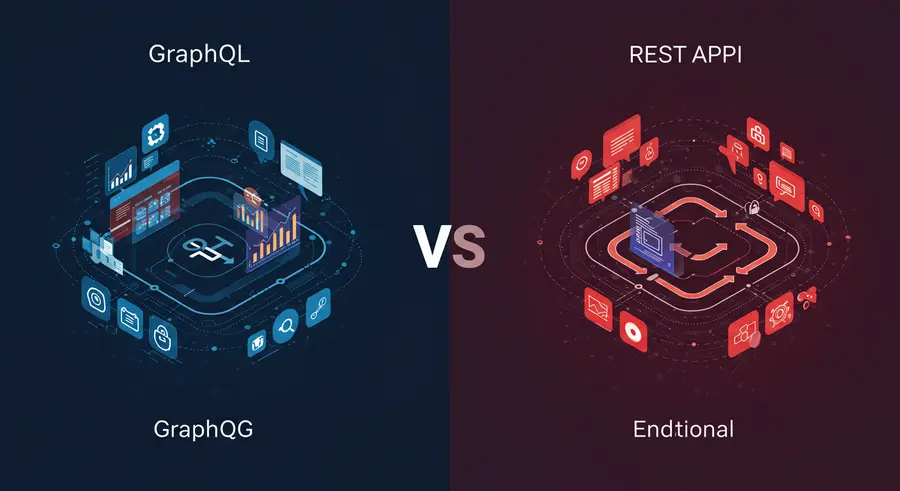Appearance

Welcome, tech enthusiasts! 👋 Today, we're embarking on an exciting journey to explore the two titans of API architecture: GraphQL and REST (Representational State Transfer). If you're involved in web development, you've undoubtedly encountered both. But what truly sets them apart, and when should you choose one over the other? Let's break it down in a way that's easy to understand, packed with examples and insights!
The Evolution of APIs: From REST to GraphQL 🌐
For over a decade, REST has been the de facto standard for designing web APIs. It's simple, stateless, and leverages standard HTTP methods (GET, POST, PUT, DELETE) to interact with resources. However, as client applications grew more complex and data requirements became more dynamic, the limitations of REST started to surface.
Enter GraphQL, developed and open-sourced by Facebook in 2015. GraphQL isn't an architectural style like REST; it's a query language for your API and a server-side runtime for executing those queries using a type system you define for your data. Think of it as a way for your client to ask for exactly what it needs, no more, no less.
Key Differences: GraphQL vs. REST 🆚
Let's dive into the fundamental distinctions that define these two powerful API paradigms:
1. Endpoints and Data Fetching 🎯
REST: Relies on multiple endpoints, each representing a specific resource. To get data about a user and their posts, you might make two separate requests:
/users/{id}and/users/{id}/posts.- Problem: This can lead to over-fetching (receiving more data than needed) or under-fetching (needing to make multiple requests to get all required data).
GraphQL: Exposes a single endpoint. Clients send queries to this endpoint, specifying the exact data structure they need.
- Solution: Eliminates over-fetching and under-fetching. You get precisely what you ask for in a single request.
graphqlquery GetUserAndPosts { user(id: "123") { name email posts { title content } } }This single query fetches user details and their associated posts. Efficient, right? 🚀
2. Data Structure and Schemas 🧱
REST: Typically relies on predefined resource structures. Changes to the API often require versioning (
/v1/users,/v2/users), which can be cumbersome.GraphQL: Built around a strong type system defined in a schema. This schema describes all possible data and operations. Clients can introspect the schema to understand what's available.
- Advantage: Self-documenting API, making development faster and less error-prone. Changes can often be made without breaking existing clients by simply adding new fields.
3. Versioning 🕰️
REST: Often uses URL versioning (
/api/v1/users) or header versioning. Managing multiple API versions can be complex.GraphQL: Versioning is less of a concern. You can add new fields and types to your schema without impacting existing queries. Deprecated fields can be marked as such, allowing clients to gradually migrate.
4. Error Handling 🚨
REST: HTTP status codes (200 OK, 404 Not Found, 500 Internal Server Error) are used to indicate success or failure.
GraphQL: Always returns a
200 OKstatus code for a valid request, even if there are errors within the data payload. Errors are returned in a dedicatederrorsfield in the response. This requires clients to parse the response body for both data and potential errors.
5. Caching 📦
REST: Leverages HTTP caching mechanisms (e.g.,
Cache-Controlheaders) effectively due to its resource-based nature and standard HTTP methods.GraphQL: Caching is more complex at the HTTP layer because all requests go to a single endpoint (typically a POST request). Client-side caching often requires more sophisticated solutions like Apollo Client's normalized cache.
When to Choose Which? 🤔
Both GraphQL and REST are powerful and have their sweet spots.
Choose REST when:
- Simplicity is key: For straightforward APIs with predictable data needs.
- Resource-oriented services: When your data can be easily modeled as distinct resources.
- Existing infrastructure: If you have a mature REST ecosystem and no pressing need for GraphQL's specific benefits.
- Public APIs: When you want to expose an API that is easy for general consumers to understand and use without a steep learning curve.
Choose GraphQL when:
- Complex data requirements: When clients need to fetch data from multiple resources in a single request or have highly specific data needs (e.g., mobile apps).
- Rapidly evolving frontends: When your client applications change frequently, and you need flexibility in data fetching without constant backend modifications.
- Aggregating data from multiple sources: GraphQL can act as a facade, unifying data from various microservices or legacy systems.
- Real-time data: With subscriptions, GraphQL is excellent for real-time updates (e.g., chat applications, live dashboards).
Real-world Examples 🌍
- REST: Often used for traditional CRUD (Create, Read, Update, Delete) operations, like a blog API where you fetch all posts, then a single post by ID, etc.
- GraphQL: Powering modern applications like Facebook's News Feed, GitHub's API, and Shopify's storefronts, where clients need highly customizable data fetches.
Conclusion 🎉
The choice between GraphQL and REST isn't about which is inherently "better," but rather which is "better suited" for your specific project needs. REST remains a robust and widely adopted standard, particularly for simpler APIs. GraphQL, with its unparalleled flexibility and efficiency in data fetching, is rapidly gaining traction for complex, data-intensive applications.
Understanding the strengths and weaknesses of both will empower you to make informed architectural decisions. Whether you're building a new application or modernizing an existing one, carefully consider your data requirements, client needs, and development workflow.
For more information about GraphQL and its capabilities, check out our catalogue page: Deep Dive into GraphQL
Happy coding! 💻✨